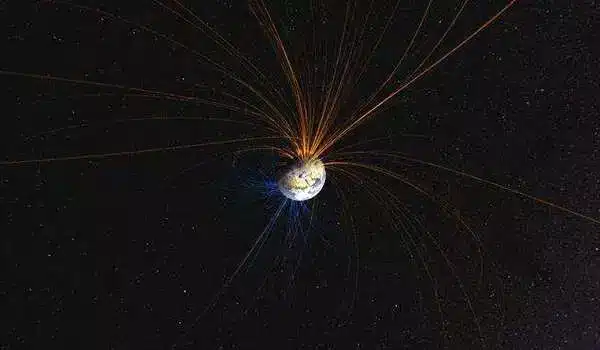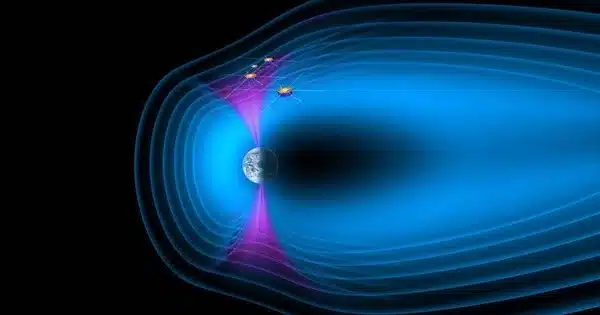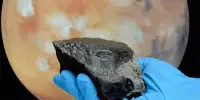Observations made by the Mio spacecraft during two flybys as part of the BepiColombo International Mercury Exploration Project indicated that chorus waves occur relatively locally in Mercury’s dawn sector. Mercury’s magnetic field is only approximately 1% that of Earth’s, thus it was unknown whether chorus waves would be produced as they are on Earth. The current study demonstrates that choral waves are the driving cause of Mercury’s X-ray auroras, the mechanism of which was previously unknown.
Because Mercury is the nearest planet to the Sun among the solar system planets, it is heavily influenced by the solar wind, a high-speed (several hundred km/s) jet of plasma streaming from the Sun. Mercury explorations were originally carried out by the Mariner 10 spacecraft in 1974 and 1975, which confirmed that Mercury possesses a magnetic field, and consequently a magnetosphere, similar to that of Earth.
The MESSENGER mission produced a thorough view of Mercury’s magnetic field and magnetosphere in the 2000s, revealing that Mercury’s magnetic field center is displaced northward from the planet’s center by approximately 0.2 RM (RM is Mercury’s radius of 2,439.7 km). The BepiColombo International Mercury Exploration Project [note-1]) is now exploring Mercury for the third time with the Mio spacecraft (Project Scientist, Dr. Murakami) and the Mercury Planetary Orbiter (MPO).
Japan and France collaborated to build alternating current magnetic field sensors that can withstand Mercury’s searing climate, allowing the first electromagnetic wave observations without being corrupted by noise from the spacecraft itself.
Unlike Mariner 10 and MESSENGER, the Mio spacecraft is outfitted with a full set of plasma wave instruments (PWI, Principal Investigator Prof. Kasaba) intended expressly to examine the electromagnetic environment of Mercury for the first time. Electromagnetic waves can efficiently accelerate plasma particles (electrons, protons, and heavier ions), and hence play a major role in Mercury’s magnetospheric dynamics.
The current study was carried out by an international collaborative research team comprised of scientists from Kanazawa University, Tohoku University, Kyoto University, MagneDesign Corporation, Laboratoire de Physique des Plasmas, France, and CNES (French Space Agency), as well as the Institute of Space and Astronautical Science, the Japan Aerospace Exploration Agency (JAXA).
The Mio spacecraft, which was launched on October 20, 2018, is presently on its route to Mercury, with a final orbital insertion slated for December 2025. Although putting Mio into Mercury’s orbit is technically difficult due to the Sun’s stronger gravity than Mercury’s, it is scheduled to come into orbit around Mercury in 2025 after many flybys [note-2]) of Earth, Venus, and Mercury for gravity assist procedures. The Mio spacecraft reached Mercury at an altitude of about 200 kilometers during the flybys on October 1, 2021 and June 23, 2022.

The stowed configuration of the spacecraft during the journey to Mercury is not optimal for measuring electromagnetic waves because of the interference noise coming from the spacecraft itself. However, the Mio spacecraft was developed to lower as much as possible its electromagnetic noise level, and thus has been certified as an electromagnetically clean spacecraft through EMC tests [note-3]).
Japan and France collaborated to build alternating current magnetic field sensors that can withstand Mercury’s searing climate, allowing the first electromagnetic wave observations without being corrupted by noise from the spacecraft itself. This has revealed the local creation of chorus waves, such as those commonly observed in the Earth’s magnetosphere. The presence of chorus waves in Mercury’s magnetosphere, which has recently been proven, had been expected (frequency range, intensity, etc.) since the 2000s, when the Mio spacecraft’s plasma wave instrument (PWI) was constructed.
What most surprised the international joint research team, including Dr. Ozaki of Kanazawa University, was the ”spatial locality” of the chorus waves, which were detected only in an extremely limited region in the dawn sector of the Mercury’s magnetosphere during the two flybys. This means that there is a physical mechanism that tends to generate chorus waves only in the dawn sector of the magnetosphere of Mercury.
The international joint research team used the nonlinear growth theory of chorus waves established by Prof. Omura, Kyoto University, to evaluate the effect of curvature of Mercury’s magnetic field, which is strongly distorted by the solar wind, to investigate the cause of the generation of chorus waves in the dawn sector. The solar wind pressure stretches the magnetic field lines in the night sector, whereas the magnetic field lines in the dawn sector are less affected, resulting in a lesser curvature.
Based on the magnetic field line features and the nonlinear growth theory, it is revealed that energy is readily transferred from electrons to electromagnetic waves along magnetic field lines in the dawn sector, generating conditions that favor chorus wave development. The impact is likewise confirmed by a high-performance computer simulation of the Mercury environment. The researchers used a significant synergy between “spacecraft observation,” “theory,” and “simulation” to highlight the importance of the planetary magnetic field lines, which are strongly affected by the solar wind, on the locale of choral wave creation in this study.
Future Prospects
The team prepared for the full electromagnetic environment assessment using the planned Mio spacecraft probe in orbit around Mercury during the Mercury flyby observations. Chorus waves, which were supposed to be identified at the time of planning, are noticed in a very localized manner, i.e. in Mercury’s dawn sector, which was unexpected, and the data demonstrate distinct oscillations in Mercury’s magnetosphere.
The data show that there are energetic electrons on Mercury that can generate chorus waves, that active electrons can be efficiently accelerated by chorus waves, and that X-ray auroras can be generated by electrons forcibly precipitating from Mercury’s magnetosphere to the surface of Mercury driven by chorus waves. These findings will have a significant impact on scientists’ knowledge of Mercury’s environment. The Mio spacecraft is on its way to conduct a thorough investigation of Mercury.
We discovered that magnetic field distortion is responsible for the local (i.e. dawn sector) creation of the choral waves based on flyby data. The Mio spacecraft’s complete examination of the electromagnetic environment in Mercury’s orbit will contribute not only to a better understanding of the plasma environment of the entire magnetosphere of Mercury, but also to a better understanding of magnetospheric dynamics in general. The magnetosphere protects the planets of the solar system from potentially lethal cosmic radiation. Data from Mercury and Earth will be compared to improve our understanding of our home planet’s natural shielding.
Glossary
[note-1] BepiColombo International Mercury Exploration Project
Comprehensive exploration project for Mercury using two spacecraft probes (Mio and MPO) by Japan-Europe cooperation. In particular, Japan is in charge of the Mercury magnetosphere probe Mio, equipped with electromagnetic wave observation instruments, etc.
[note-2] Flyby
With a spacecraft probe passing in proximity to a planet. The orbit of the spacecraft probe is to be changed in a desired manner by using the gravity of the planet.
[note-3] EMC (electromagnetic compatibility) test
Evaluation test to check whether unnecessary electromagnetic noise is emitted and whether the equipment is designed and manufactured in such a way that it will not malfunction even if it receives unwanted electromagnetic noise.
















